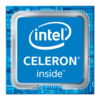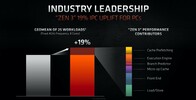Intel Celeron 5305U vs AMD Ryzen 7 5800U
Intel Celeron 5305U
► remove from comparison
The Intel Celeron 5305U is a low-power dual-core SoC for laptops, based on the Comet Lake architecture, which was introduced in 2020. Compared to Kaby Lake and Whiskey Lake, there are apparently no differences with Comet Lake apart from the two additional cores in the Top model Core i7-10710U. The processor is still manufactured using the mature 14nm process (14nm++ like Whiskey Lake). The processor cores clock at a fixed 2.3 GHz (no Turbo) and also only offer 2 threads (no HyperThreading). Compared to the more powerful Core i3, i5 and i7 variants, the Celeron does not offer SSE (2) support.
You can find more information about the Comet Lake architecture and the available processors on our Comet Lake topic page.
According to Intel, the integrated graphics card is called Intel UHD Graphics, but is an old Intel UHD Graphics 610. It is clocked in the Celeron 5205U at 300 - 900 MHz and is only sufficient for very demanding games. The CPU also offers an integrated DDR4-2666 / LPDDR4x 2933 / LPDDR3-2133 dual-channel memory controller as well as VP9 and H.265 video decoder and encoder.
Performance
The performance of the Celeron 5305U is in the lowest entry-level class of notebook processors in 2020. Due to the lack of Turbo and only 2 cores, the CPU cannot score points in either single-core or multi-core tasks. The processor is therefore only suitable for undemanding tasks such as surfing with a few tabs and office tasks.
The power consumption and performance can be set from 15 to 12.5 watts by the notebook manufacturer via cTDP-down. However, the processor then only runs at 800 MHz and significantly reduced performance. Even at 15 watts, however, the processor is suitable for thin and light notebooks.
AMD Ryzen 7 5800U
► remove from comparison
The AMD Ryzen 7 5800U is a processor for thin and light laptops based on the Cezanne generation. The R7 5800U integrates all eight cores based on the Zen 3 microarchitecture and is the fastest U-series processor at launch. They are clocked at 1.9 (guaranteed base clock) to 4.4 GHz (Turbo) and support SMT / Hyperthreading (16 threads). The chip is manufactured on the modern 7 nm TSMC process.
The new Zen 3 microarchitecture offers a significantly higher IPC (instructions per clock) compared to Zen 2. For desktop processors AMD claims 19 percent on average and in applications reviews showed around 12% gains at the same clock speed.
In addition to the eight CPU cores, the APU also integrates a Radeon RX Vega 8 GPU with 8 CUs at up to 2000 MHz. The dual channel memory controller supports DDR4-3200 and energy efficient LPDDR4-4266 RAM. Furthermore, 16 MB level 3 cache (up from 8 MB at the 4800U) can be found on the chip.
Performance
The average 5800U in our database matches the Core i5-11260H and, perhaps a little disappointingly, the Ryzen 7 4800U in multi-core performance.
Thanks to its decent cooling solution and a long-term CPU power limit of 22 W, the ProBook x360 435 G8 is among the fastest laptops powered by the 5800U that we know of. It can be more than 10% faster in CPU-bound workloads than the slowest system featuring the same chip in our database, as of August 2023.
Power consumption
This Ryzen 7 series chip has a default TDP (also known as the long-term power limit) of 15 W, a value that laptop makers are allowed to change to anything between 10 W and 25 W with clock speeds and performance changing accordingly as a result. Choosing the lowest value would allow one to build a passively cooled system around the Ryzen, however, most laptop manufacturers will do the opposite to extract as much performance out of the chip as possible.
The Ryzen 7 5800U is built with TSMC's 7 nm process for average, as of mid 2023, energy efficiency.
| Model | Intel Celeron 5305U | AMD Ryzen 7 5800U | ||||||||||||||||||||||||||||||||||||||||||||||||||||||||
| Codename | Comet Lake-U | Cezanne-U (Zen 3) | ||||||||||||||||||||||||||||||||||||||||||||||||||||||||
| Series | Intel Comet Lake | AMD Cezanne (Zen 3, Ryzen 5000) | ||||||||||||||||||||||||||||||||||||||||||||||||||||||||
| Series: Cezanne (Zen 3, Ryzen 5000) Cezanne-U (Zen 3) |
|
| ||||||||||||||||||||||||||||||||||||||||||||||||||||||||
| Clock | 2300 MHz | 1900 - 4400 MHz | ||||||||||||||||||||||||||||||||||||||||||||||||||||||||
| Cores / Threads | 2 / 2 | 8 / 16 | ||||||||||||||||||||||||||||||||||||||||||||||||||||||||
| TDP | 15 Watt | 25 Watt | ||||||||||||||||||||||||||||||||||||||||||||||||||||||||
| Technology | 14 nm | 7 nm | ||||||||||||||||||||||||||||||||||||||||||||||||||||||||
| max. Temp. | 100 °C | 105 °C | ||||||||||||||||||||||||||||||||||||||||||||||||||||||||
| Socket | BGA1528 | FP6 | ||||||||||||||||||||||||||||||||||||||||||||||||||||||||
| Features | LPDDR3-2133/DDR4-2400 RAM, PCIe 2, 4 GT/s bus, MMX, SSE, SSE2, SSE3, SSSE3, SSE4.1, SSE4.2, AVX, AVX2, BMI2, ABM, FMA, ADX, VMX, SMEP, SMAP, MPX, EIST, TM1, TM2, SST, AES-NI, RDRAND, RDSEED, SGX | DDR4-3200/LPDDR4-4266 RAM, PCIe 3, MMX, SSE, SSE2, SSE3, SSSE3, SSE4A, SSE4.1, SSE4.2, AVX, AVX2, BMI2, ABM, FMA, ADX, SMEP, SMAP, SMT, CPB, AES-NI, RDRAND, RDSEED, SHA, SME | ||||||||||||||||||||||||||||||||||||||||||||||||||||||||
| iGPU | Intel UHD Graphics 610 (300 - 900 MHz) | AMD Radeon RX Vega 8 (Ryzen 4000/5000) ( - 2000 MHz) | ||||||||||||||||||||||||||||||||||||||||||||||||||||||||
| Architecture | x86 | x86 | ||||||||||||||||||||||||||||||||||||||||||||||||||||||||
| $107 U.S. | ||||||||||||||||||||||||||||||||||||||||||||||||||||||||||
| Announced | ||||||||||||||||||||||||||||||||||||||||||||||||||||||||||
| Manufacturer | ark.intel.com | www.amd.com | ||||||||||||||||||||||||||||||||||||||||||||||||||||||||
| L1 Cache | 512 KB | |||||||||||||||||||||||||||||||||||||||||||||||||||||||||
| L2 Cache | 4 MB | |||||||||||||||||||||||||||||||||||||||||||||||||||||||||
| L3 Cache | 16 MB |
Benchmarks
Average Benchmarks Intel Celeron 5305U → 0% n=0
Average Benchmarks AMD Ryzen 7 5800U → 0% n=0
* Smaller numbers mean a higher performance
1 This benchmark is not used for the average calculation













